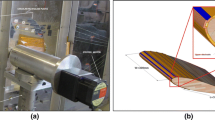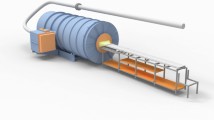Abstract
The purpose of the study is to numerically, experimentally, and analytically investigate the characteristics of plasma pulsed thermal actuators (PT actuators) and to assess their possibilities in controlling flow around airfoils, wings, and configurations at large subsonic freestream velocities. For the PT actuators of the types considered the mathematical models adequately describing their effect on flow past bodies are developed. The characteristics of a prototype PT actuator are experimentally investigated on a specially developed rig. A new type of the PT actuator equippedwith a channel (PTC actuator) is proposed; it is designed to operate at a high pulse repetition frequency and at large flow velocities. Numerical investigations show that the PTC actuators are free of the essential and fundamental shortcoming of the PT actuators which consists in the working zone superheating at high pulse repetition frequencies.
Similar content being viewed by others
References
A. V. Petrov, Power-Based Methods of Increasing the Wing Lift [in Russian] (Fizmatlit, Moscow, 2011).
V. M. Lutovinov, “Problems and Methods of Laminarization at Subsonic Velocities,” Tr. TsAGI No. 2665, 1 (2004).
A. S. Petrov, Theory of Aerodynamic Forces at Subsonic Velocities. A Handbook [in Russian] (Moscow Institute of Physics and Technology, 2007).
A. S. Petrov, “Thermodynamic Efficiency of Reducing theWave Drag Using Thermal Energy Addition into a Local Supersonic Zone of an Airfoil,” Uch. Zap. TsAGI 39 (3), 3 (2008).
M. A. Starodubtsev, “The Control of Transonic Flow around an Aerodynamic Airfoil Using Heat Addition,” Uch. Zap. TsAGI 38 (1–2), 36 (2007).
A. S. Petrov, “Total Body Drag in a Flow of a Viscous, Heat-Conducting Gas,” Uch. Zap. TsAGI 22 (2), 57 (1991).
V. V. Kozlov, “Flow Separation from a Leading Edge and the Influence of Acoustic Disturbances on It,” Zh. Prikl.Mekh. Tekhn. Fiz., 2, 112 (1985).
P. K. Chang, Control of Flow Separation: Energy Conservation, Operational Efficiency and Safety (McGraw-Hill, New York, 1978).
N. Benard and E. Moreau, “EHD Force and ElectricWind Produced by Surface Dielectric Barrier Discharge Plasma Actuators Used for Airflow Control,” AIAA Paper No. 3136 (2012).
V. R. Soloviev, “Analytical Estimation of the Thrust Generated by a Surface Dielectric Barrier Discharge,” J. Phys. D:Appl. Phys. 45, 025205 (2012).
V. R. Soloviev and V. M. Krivtsov, “Surface Barrier Discharge Modelling for Aerodynamic Applications,” J. Phys. D:Appl. Phys. 42, 125208 (2009).
J. Kriegseis, “Performance Characterization and Quantification of Dielectric Barrier Discharge Plasma Actuators,” Dr.-Eng. Dissertation, Darmstadt Univ. (2011).
J. Loiseau, J. Batina, and R. Peyrous, “Hydrodynamical Simulation of the Electric Wind Generated by Successive Streamers in a Point-to-Point Reactor,” J. Phys. D:Appl. Phys. 35, 1020 (2002).
M. Rickard, D. Dunn-Rankin, F. Weinberg, and F. Carleton, “Maximizing Ion-Driven Gas Flows,” J. Electrostatics 64, 368 (2006).
H. Velkoff and J. Ketchman, “Effect of an Electrostatic Field on Boundary Layer Transition,” AIAA J. 6 (7), 1381 (1968).
F. Soetomo, “The Influence of High Voltage Discharge on Flat Plate Drag at Low Reynolds Number Air Flow,” MS Thesis, Iowa State Univ. (1992).
G. Artana, J. Adamo, L. Leger, E. Moreau, and G. Touchard, “Flow Control with Electrohydrodynamic Actuators,” AIAA J. 40 (9), 1773 (2002).
L. Leger, E. Moreau, and G. Touchard, “Electrohydrodynamic Airflow Control along a Flat Plate by a DC Surface Corona Discharge—Velocity Profile and Wall PressureMeasurements,” AIAA Paper No. 2833 (2002)
E. Moreau, L. Leger, and G. Touchard, “Effect of a DC Surface Non-thermal Plasma on a Flat Plate Boundary Layer for Airflow Velocity up to 25 m/s,” J. Electrostatics 64, 215 (2006).
M. Hamdi, M. Havet, O. Rouaud, and D. Tarlet, “Comparison of Different Tracers for PIV Measurement in EHD Flows,” Exper. Fluids 55, 1702 (2014).
Lin Wang, Zhi-xun Xia, Hen-bing Luo, and Jun Chen, “Three-Electrode Plasma Synthetic Jet Actuator for High-Speed Flow Control,” AIAA J. 52 (4), 879 (2014).
Author information
Authors and Affiliations
Corresponding author
Additional information
Original Russian Text © A.V. Voevodin, A.S. Petrov, D.A. Petrov, G.G. Sudakov, 2018, published in Izvestiya Rossiiskoi Akademii Nauk, Mekhanika Zhidkosti i Gaza, 2018, No. 1, pp. 107–120.
Rights and permissions
About this article
Cite this article
Voevodin, A.V., Petrov, A.S., Petrov, D.A. et al. Experimental and Numerical Investigations of the Characteristics of Pulsed Thermal Actuators. Fluid Dyn 53, 105–118 (2018). https://doi.org/10.1134/S0015462818010159
Received:
Published:
Issue Date:
DOI: https://doi.org/10.1134/S0015462818010159




